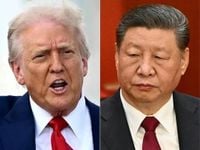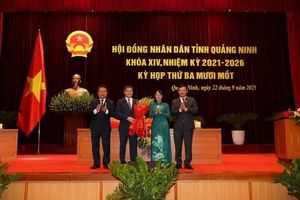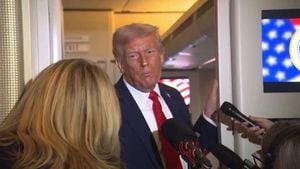In a move that has captured the world’s attention, U.S. President Donald Trump and Chinese President Xi Jinping are set to meet at the end of October 2025 in the historic city of Gyeongju, South Korea, during the Asian Pacific Economic Cooperation (APEC) summit. According to Bloomberg and The New York Sun, this highly anticipated encounter follows a breakthrough in the ongoing saga over TikTok—a social media platform at the center of U.S.-China tech tensions—and is poised to address a host of thorny issues that have defined the relationship between the two superpowers for years.
This meeting will mark the first time Trump and Xi have sat down face-to-face since June 2019. The location is symbolic: Gyeongju, once the capital of an ancient Korean kingdom, is now set to play host to a summit that could shape the future of the Indo-Pacific region. The air is thick with anticipation—will this be a turning point or just another round in the diplomatic dance?
The stakes are high. As The New York Sun notes, the agenda is packed with contentious issues: tariffs, trade imbalances, Taiwan, the South China Sea, and the fate of TikTok. While no one expects a definitive agreement on all fronts, the fact that Trump and Xi are even meeting is being seen as a significant step toward easing tensions.
China’s state news agency, Xinhua, reported that during a recent phone call, Xi Jinping spoke of the need for “mutual success and shared prosperity” through “joint efforts” and “win-win cooperation.” The language may sound familiar—almost diplomatic boilerplate—but it signals Beijing’s desire to project optimism, at least in public. As Xinhua put it, both countries could achieve great things if they simply worked together.
Yet, as is often the case in diplomacy, the devil is in the details. Trump, for his part, has expressed hope about closing a deal that would allow TikTok to continue operating in the United States. The platform, which boasts some 170 million American users, has been caught in the crossfire of U.S.-China tech rivalry. According to the BBC, the main sticking point in ongoing negotiations is control over TikTok’s powerful content algorithm. Trump, after a meeting with Britain’s Prime Minister Keir Starmer, remarked that potential investors in TikTok were “doing it in conjunction with China.” Meanwhile, Xinhua emphasized that China was open to “commercial negotiations based on market rules.”
Despite the optimistic rhetoric, there’s a clear divergence in how each side is presenting the upcoming summit. Trump has openly discussed the meeting and even floated the possibility of a subsequent trip to China for another round of talks. Xinhua, by contrast, has been more circumspect, omitting any mention of Xi traveling to South Korea or meeting Trump in Beijing. This difference in tone underscores the complexity—and fragility—of the current diplomatic thaw.
Adding another layer to the summit’s importance, South Korean President Lee Jae-myung will also attend the APEC gathering. However, according to The New York Sun, he may not meet one-on-one with Trump, having recently seen him in Washington and planning to cross paths at the United Nations General Assembly in New York. Xi, for his part, is not expected to attend the UN gathering, making the APEC summit in Gyeongju all the more consequential as a "safety valve" for regional tensions.
Beyond the TikTok negotiations, the summit arrives at a moment of shifting dynamics in the U.S.-China relationship. Tensions over Taiwan remain front and center. For decades, the U.S. has been a steadfast supporter of Taiwan, which continues to govern itself independently of Beijing. However, recent developments suggest a subtle recalibration of Washington’s stance. As reported by the South China Morning Post, the U.S. has adopted a "low-publicity approach" to sending warships through the Taiwan Strait since Trump’s return to power—perhaps an attempt to tamp down tensions with Beijing. Furthermore, the Associated Press notes that Trump has refused more than $400 million in military aid for Taiwan, a move interpreted by some as a potential shift in U.S. policy.
Meanwhile, the region has been on edge following a massive “victory parade” in Beijing, where Xi hosted both Russia’s President Vladimir Putin and North Korea’s leader Kim Jong-un to mark 80 years since Japan’s surrender at the end of World War II. Notably, Xi’s remarks at the event recalled the alliance between China and the United States during the war, stating that the Chinese “would never forget the valuable support provided by the United States and other anti-fascist allies to China’s War of Resistance against Japanese Aggression.” This acknowledgment stands in contrast to the historical reality that the U.S. primarily supported the anti-Communist Nationalist forces under Chiang Kai-shek—who ultimately retreated to Taiwan as Mao Zedong’s Communist army took control of the mainland in 1949.
The upcoming summit is therefore freighted with historical echoes and present-day anxieties. From Beijing’s perspective, the meeting offers a chance to showcase China’s willingness to engage in "win-win cooperation"—even as it continues to assert its claims over Taiwan and the South China Sea. For Washington, the summit represents an opportunity to press for concessions on trade and technology, while signaling a possible recalibration of its security commitments in the region.
Observers on both sides of the Pacific are watching closely. Some see the summit as a necessary reset, a chance to cool down a relationship that has grown dangerously adversarial. Others worry that the flurry of diplomatic activity masks deeper, unresolved differences that could flare up again at any moment.
One thing is certain: the world will be watching Gyeongju at the end of October. Whether Trump and Xi can move beyond friendly photo-ops and vague pledges of cooperation to achieve tangible progress remains to be seen. But in a world marked by uncertainty and rapid change, even the possibility of dialogue is enough to make headlines—and maybe, just maybe, to shift the course of history.




